![]()
Budget 2005 - Budget Plan
- Table of Contents - Previous
- Next -
Annex 3
Canada's Demographic Challenge
Introduction
Population aging is a worldwide phenomenon, but over the next 25 years Canada is expected to experience one of the largest increases in the ratio of the elderly to the working-age population among Group of Seven (G-7) countries. This trend presents an important challenge to the continued improvement of living standards and to the sustainability of social programs in Canada in the decades to come.
With the reduction of the public debt burden over the last 10 years and the 1997 reforms to the Canada Pension Plan, Canada is better positioned than most other G-7 countries to cope with emerging demographic pressures. However, further reductions in the debt burden are required to increase Canada’s flexibility to address future demands on Canada’s universal public pension and health care systems. As well, with pressures on the health care system already being significant, it will be increasingly important for governments to continue with health care reforms and to support gross domestic product (GDP) growth—the source of society’s capacity to pay for public services.
However, sustaining growth in GDP per capita—the most commonly used measure of the average standard of living—will become more challenging as the population ages. This is because the share of the population that is working is projected to start to decline after 2010 as the baby boom generation enters retirement age. This will exert downward pressure on the growth of living standards. To help partially counter the impact of aging, it will be important to take steps to facilitate the full integration of new immigrants and Aboriginal people into the labour market and ensure that older Canadians who want to continue to participate in the labour market do not face undue institutional or financial disincentives to do so.
Nevertheless, continued improvements in the living standards of Canadians will have to rely increasingly on productivity growth. Therefore, to increase living standards, Canada must continue to invest in the drivers of productivity growth: human capital, physical capital and innovation. Building on a sound fiscal foundation, the role of the Government is to enhance and strengthen policies that encourage all Canadians to invest in these drivers of growth.
Population aging will be a key challenge facing the Canadian economy over the coming decades
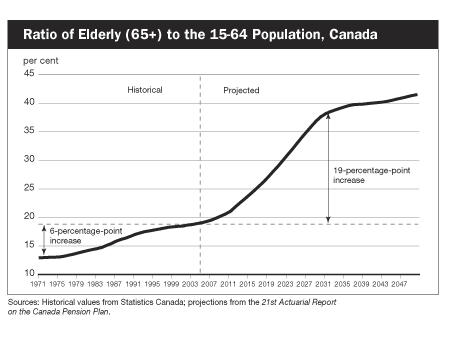
- Population aging results from a decline in fertility rates following the baby boom and the continuing rise in life expectancy observed over the last century.[1]
- In Canada, over the last 30 years the ratio of the elderly (65+) to the 15-64 population increased by only 6 percentage points. In the next 25 years this ratio is expected to double from its current level to almost 40 per cent, as the baby boom generation enters retirement age.
- Currently there are more than five people of working age (15-64) for every person of retirement age (65+). Within the next 15 years, this ratio is projected to rise to four to one, and by 2050, it is expected to be less than 2.5 to one.
Population aging is a worldwide phenomenon that will affect all G-7 countries

- Currently Canada’s ratio of the elderly population to the 15-64 population is the second lowest among G-7 countries, just ahead of the U.S. However, this is expected to change over the next 25 years.
- Indeed, Canada’s ratio of elderly to the 15-64 population is projected to increase by 20 percentage points by 2030 to almost 40 per cent, increasing the gap with the U.S. Canada’s elderly ratio is projected to move slightly above the European average, but it is still expected to be lower than that of larger continental European countries and Japan.
- Beyond 2030 the increase in Canada’s ratio of elderly to the 15-64 population is expected to taper off, increasing by about 5 percentage points over a period of 20 years.
- In comparison, Japan’s ratio of elderly to the 15-64 population is projected to increase by an additional 20 percentage points from 2030 to 2050, while that of Europe is expected to increase by 12 percentage points.
However, Canada will experience one of the largest increases in the ratio of the elderly to the 15-64 population over the next 25 years

- Over the next 25 years Canada is projected to experience one of the largest increases in the ratio of elderly to the 15-64 population (20 percentage points) among G-7 countries—second only to Japan.
- This mainly reflects a sharper decline in the fertility rate in Canada than in other G-7 countries. Indeed, Canada went from having by far the highest fertility rate among G-7 countries in 1960 to falling within the average of G-7 countries in 1998.[2]
- Only three other developed countries are expected to experience an increase of 20 percentage points or more in their ratio of elderly to the 15-64 population between 2005 and 2030 (Switzerland, Japan and Finland).
- For Canada, as well as for other industrialized countries, this demographic transition will make continued improvements in living standards and the sustainability of social programs more challenging in decades to come.
The reduction of the public debt burden since 1995 has put Canada in a better position to face emerging demands on social programs
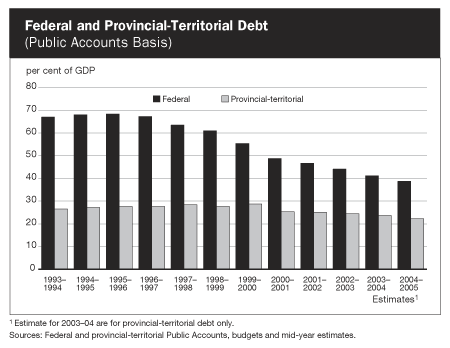
- Population aging will bring about increased demands on social programs, particularly health care and public pensions. Canada has already taken significant steps to prepare for these fiscal pressures.
- The reduction in the ratio of public debt to GDP over the past 10 years at the federal and provincial-territorial levels, together with the federal government’s objective of further reducing its debt-to-GDP ratio to 25 per cent by 2014–15, are key elements in preparing Canada for the fiscal challenges associated with population aging.
- On a National Accounts basis, Canada went from having the second highest total government debt-to-GDP ratio among G-7 countries in 1995 to the lowest since 2003.
- This impressive record led the International Monetary Fund (IMF) to conclude in its most recent assessment of Canada’s economy that "… the fiscal system was well placed to cope with expected pressures from population aging compared with many other G-7 countries…"[3]
Lower debt charges mean more flexibility to deal with emerging demographic spending pressures
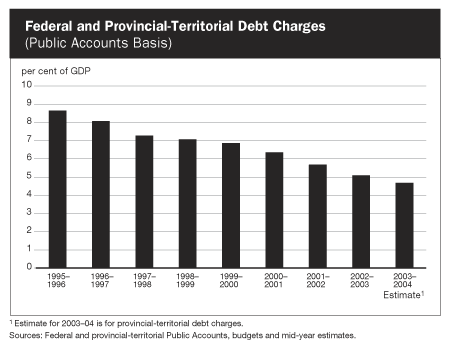
- The reduction of the public debt burden and the decline in interest rates, which in part result from governments’ greater fiscal credibility, mean that a smaller share of government revenues go to paying interest on public debt. Hence, more of what governments collect in revenue is and will continue to be available to fund social programs, including age-related ones.
- Expressed as a percentage of GDP, federal-provincial-territorial debt charges have been reduced by almost half: from 8.6 per cent in 1995–96 to 4.7 per cent in 2003–04.
- Keeping the debt burden on a steady downward track will therefore afford additional flexibility in meeting emerging demographic pressures.
Canada’s retirement income system is on solid ground
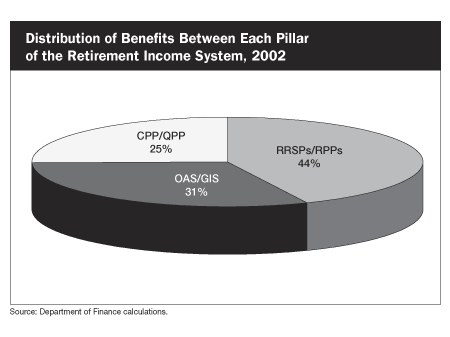
- Canada’s retirement income system is based on three pillars:
- The Old Age Security and Guaranteed Income Supplement (OAS/GIS) programs, funded through general federal revenues, provide a basic minimum income guarantee for seniors.
- The Canada Pension Plan (CPP) and Quebec Pension Plan (QPP), funded through payroll contributions, ensure a basic level of earnings replacement in retirement for working Canadians.
- Private tax-assisted retirement savings in registered retirement savings plans (RRSPs) and registered pension plans (RPPs) help and encourage Canadians to save for retirement to supplement their public pensions.
- According to the 21st Actuarial Report on the Canada Pension Plan released in 2004 and the IMF,[4] the 1997 reforms have ensured the sustainability of the CPP for at least the next 75 years. Canada is one of very few countries with an actuarially sound public pension plan.
- The Government has also increased and indexed RPP and RRSP limits in Budget 2005.
- By achieving balanced budgets and reducing the debt-to-GDP ratio, the Government has increased its flexibility to deal with the pressures aging will exert on the OAS and GIS programs.
Population aging will exert significant pressure on government spending, particularly on health care …
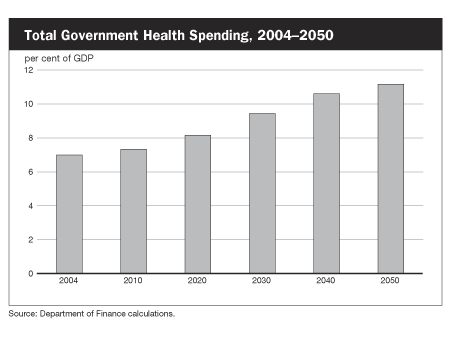
- Population aging will exert significant upward pressure on some age-related government expenditures such as universal public pensions and particularly health care.
- The estimated impact of population aging on government health care spending over the long term can be illustrated by overlaying existing age-specific expenditure patterns onto future demographic projections.[5] Using this approach, changes in the demographic composition of the population are expected to increase government health care expenditures to 11.2 per cent of GDP by 2050, up from 7.1 per cent in 2004.
- As is the case in any projection, there is considerable uncertainty surrounding these estimates. That said, these projections provide an indication of the magnitude of long-term government health care spending pressures arising from aging.
… but health care spending pressures may not stem from aging alone
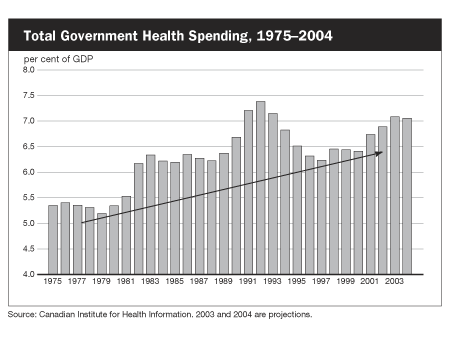
- Population aging will put significant pressure on government expenditures, but these pressures may not stem from aging alone.
- Over the last 25 years, government health care spending as a share of GDP has increased by close to 2 percentage points to reach 7.1 per cent in 2004. This increase reflects the growing availability of health care technology and treatments, along with rising costs of certain health care services. It also reflects Canadians’ growing income and increased willingness to spend more on health.
- Going forward, it will be important to continue with reforms to the health care system to ensure both the quality of care and the efficient allocation of health care dollars.
- Keeping Canada’s debt-to-GDP ratio on a downward track will also be essential in helping the Government meet future fiscal pressures.
- Finally, it will be important to foster strong economic growth in order to have the necessary financial resources to support social programs, especially health care.
Population aging will also tend to reduce economic growth and improvements in living standards

- While it is crucial to sustain strong economic growth to prepare for age-related fiscal pressures, this in itself will pose a challenge because population aging will tend to reduce economic and living standards growth.
- GDP per person, the most commonly used measure of the average standard of living, is essentially driven by two factors: the share of the population that is working—the employment-to-population ratio—and how much each employed person produces—productivity.[6]
- While an increased share of the population working has been a key source of growth in living standards in recent decades, this will not continue as the population ages.
- Therefore, from a public policy point of view, one of the main challenges surrounding population aging will be to ensure sustained growth in living standards through productivity growth over decades to come.
The projected decline in the employment-to-population ratio will gradually become a hindrance to growth in living standards beyond 2010

- Over the past 30 years, the employment-to-population ratio has risen because of the entry of the baby boom generation into the workforce and the greater labour force participation of women.
- The aging of Canada’s population means that the composition of the labour force source population (15 and over) will become increasingly older over time.
- Given the relatively lower labour force attachment of older workers, population aging is projected to reduce the labour force participation rate, resulting in a gradual decline in the employment-to-population ratio after 2010.[7]
- The expected fall in the employment-to-population ratio could subtract, on average, as much as 0.5 percentage points per year from real GDP per capita growth over the 2010–2030 period, exerting downward pressure on improvements in living standards.
With the upcoming labour scarcity, there is a need to facilitate the integration of immigrants into the labour market …

- With the upcoming labour scarcity, it is imperative that all Canadians who are willing and able to work have the opportunity to do so.
- Immigrants, particularly those recently established in Canada, have typically had lower employment rates than the rest of the population.
- While recent immigrants have made some progress between 1996 and 2001 relative to individuals born in Canada, their employment rate in 2001 remained lower than that of the Canadian-born. Furthermore, relative to 1991, the employment rate gap between these two groups has increased from 4.2 to 7.7 percentage points.
- Immigrants will compose an increasing share of the working-age population in the decades to come. It is therefore of crucial importance to facilitate their integration into the labour market.
- As is the case with recent immigrants, Aboriginal people have traditionally had lower employment rates than other Canadians. However, in contrast to recent immigrants, their employment rate fell between 1996 and 2001. Continuing efforts to integrate Aboriginal people successfully into the labour market will be required for Canada to fulfill its economic and social potential.
… and to ensure that older Canadians do not face disincentives to work
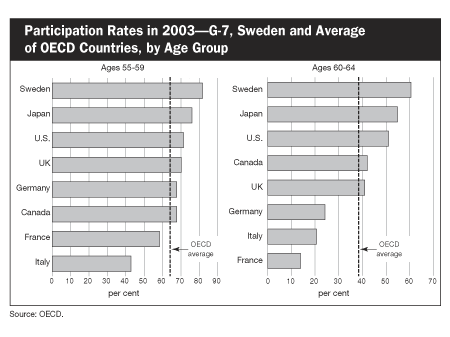
- In an aging society, Canada should also ensure that older individuals who wish to continue to take part in the labour market are able to do so.
- The participation rates of older Canadians have increased by almost 10 percentage points since 1996 and are now comparable to averages for members of the Organisation for Economic Co-operation and Development (OECD).
- However, in some OECD countries, such as Japan, the U.S. and most Nordic countries, older people have markedly higher participation rates.
- Minimizing institutional and financial disincentives to work has the potential to raise the labour force attachment of older Canadians.[8]
- While increasing the labour force attachment of older workers, immigrants and Aboriginal people will help Canada achieve its full economic and social potential, the share of the Canadian population that is working will nevertheless soon begin to fall as a consequence of population aging.
- Therefore, increasing productivity constitutes the main channel through which to ensure sustained growth in living standards.
Improvements in the living standards of Canadians will increasingly have to rely on productivity
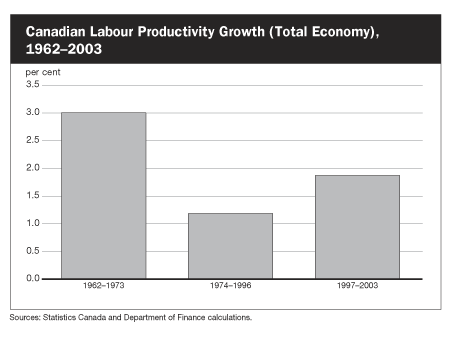
- Since 1997 Canada’s productivity growth has improved. The investment in and use of information and communications technologies have been key drivers in this recent improved productivity performance.
- But the productivity outlook is highly uncertain. On average, productivity growth was 3 per cent between 1962 and 1973, declined to 1.2 per cent for the following two decades and then increased again to 1.9 per cent between 1997 and 2003.
- The Government has put in place a sound macroeconomic framework to support productivity. Nevertheless, this does not guarantee that productivity growth will not slow down in the future—as it did in the early 1970s.[9]
- Given the growing importance of productivity for living standards, this sound macroeconomic framework is now more important than ever to ensure that Canada takes advantage of emerging technological opportunities and mitigates potential productivity growth slowdowns.
- And, over long periods, even a small increase in productivity growth has significant implications for living standards and the financial sustainability of social programs.
Canada must concentrate on the drivers of productivity growth

- To increase living standards, Canada must concentrate on the drivers of productivity growth: human capital, physical capital and innovation.
- Productivity can be improved directly through higher investment in human and physical capital. Human capital investment increases workers’ efficiency and effectiveness, while providing workers with additional and better equipment enables them to produce more goods and services.
- Larger investments in human and physical capital can also increase productivity indirectly through increased innovation. Innovation provides the technology and production practices to help improve the way workers do things, and results in greater efficiency. Innovation also provides the opportunity for entirely new kinds of goods and services to be produced.
- These drivers of productivity reinforce each other. Innovation produces new ideas that may be embedded in new physical capital, which in turn can be exploited by skilled workers to increase productivity.
Sound macroeconomic and structural policies support productivity growth
| Policy Framework to Improve Productivity | |
|
Macroeconomic Policies
|
Structural Policies
|
- Since most investments in the drivers of productivity growth are made by individuals and businesses, the role of the Government is to enhance and strengthen its policy framework to encourage all Canadians to invest more in these drivers.
- The first step in setting such a policy framework is to create macroeconomic conditions that are conducive to investment and productivity growth.
- Low and stable inflation and sound fiscal management keep interest rates low, reduce uncertainty and boost confidence. These in turn encourage investment in human and physical capital and innovation, and therefore promote productivity growth.
- While a sound macroeconomic policy is essential to a productivity-enhancing framework, it must be complemented with structural policies that encourage and support investment in the drivers of growth.
- The Government has taken steps in that direction in recent years and will continue to do so, but above all, the sound macroeconomic policy framework that has been put in place must be preserved.
1 From the early 1940s to the early 1960s the Canadian fertility rate (average number of children born to each woman aged 15 to 45) increased from 2.8 to 3.9. By the late 1970s the fertility rate had fallen to 1.7, and estimates for 2004 show it has dropped further to around 1.5. The life expectancy at birth of males and females has increased steadily over the past 60 years. The life expectancy of females increased from about 66 years in the early 1940s to 79 years by the late 1970s and to just over 82 years in 2004. Males have seen their life expectancy increase from about 62 years in the early 1940s to 72 years by the late 1970s and to 78 years today. [Return]
2 Canada’s fertility rate was 3.9 in 1960 and 1.5 in 1998 (as opposed to the corresponding average figures of 2.8 and 1.6 for G-7 countries, and of 3.2 and 2.1 for the United States). [Return]
3 IMF, Canada: 2004 Article IV Consultation—Staff Report; Staff Statement; and Public Information Notice on the Executive Board Discussion, p. 12. [Return]
4 IMF, Canada: 2004 Article IV Consultation—Staff Report; Staff Statement; and Public Information Notice on the Executive Board Discussion, p. 12. [Return]
5 This approach assumes that health expenditures for each age group are growing in line with increases in GDP. Therefore, it is the change in the relative size of various age groups that drives the increases in health care expenditures as a proportion of GDP. [Return]
6 Since productivity is best measured by real GDP per hour, changes in real GDP per capita also depend on changes in hours per worker. For ease of presentation, however, we disregard the hours-per-worker dimension in what follows. Hours per worker have been trending down for 25 years. If this trend continues in coming decades, hours per worker would continue to exert downward pressure on growth in GDP per capita and, hence, add to the pressures expected from the reductions in the employment-to-population ratio. [Return]
7 Underlying labour market assumptions up to 2010 are based on the average private sector survey. After 2010 the employment projection is mainly based on a participation rate projection that takes into account birth cohort effects, which are expected to somewhat increase the participation rates of older workers. Over the whole period demographic projections are from the 21st Actuarial Report on the Canada Pension Plan. [Return]
8 Increasing the labour force participation rate of older workers (persons aged 55 to 64) by 10 percentage points would increase the overall employment-to-population ratio by approximately 1.5 percentage points on average over the projection period, without, however, changing the overall trend of the ratio. [Return]
9 Economic research suggests that aging in itself may have both positive and negative effects on productivity growth. However, the net effect of aging on productivity growth is likely to be small as compared to potential changes in the pace of technological progress. [Return]
- Table of Contents - Previous - Next -
|
|
|||||
| Last Updated: 2005-02-23 | |||||